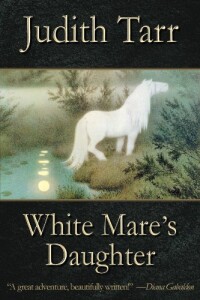 Rebecca Swain wrote this review.
Rebecca Swain wrote this review.
Misogynists, beware, this book is not for you! It is a celebration of big-breasted, powerful women, wild, proud horses, and what happens when men try to break them. It is a vibrant and fascinating portrayal of the conflict that arises when a male-dominated nomadic culture meets a settled, city-dwelling matriarchy.
The plot is based on historical fact. According to the Author’s Note, settlements the size of medieval cities existed in eastern Europe and western Asia from 7000 B.C. to about 3000 B.C. Between 4500 B.C. and 3000 B.C., these cities were overrun and conquered by tribes of nomadic horsemen from the steppes of Asia. Tarr takes these historical facts and weaves them into an interesting, readable story about Sarama and Agni, offspring of the king of the White Horse tribe of the steppe, who find their way west to the city of Three Birds. Here they meet Danu and Tilia, son and daughter of the Mother, the wise, benevolent ruler of that city.
As time goes by, more and more steppe tribes come west seeking riches and domination of the cities, and the western people must decide whether to abide by their peace-loving traditions and surrender to the conquerors, or learn to fight, something even their men have never done. In the course of this larger struggle, two couples fall in love, and their relationships mirror the wonder and sadness of conquest and assimilation.
Horses play a prominent role in this novel. They are the nomads’ most prized property. A boy cannot become a man and full member of his tribe until he has caught and tamed a wild stallion and ridden him back to the tribal encampment in triumph.
Skyfather, the male deity worshipped by the steppe people, requires a blood sacrifice, which is provided by killing a horse; the king then sits on the horsehide to perform his kingly functions of ruler and advisor for that year.
Sarama and other women of her tribe are chosen as servants of Horse Goddess, a female deity older than Skyfather but now less powerful; they serve the Mare, the equine embodiment of the Goddess. Tarr’s descriptions of horses are knowledgeable and loving, and she makes them integral to the plot, not just background decoration.
Then there are the women. The women of the steppe are subservient, powerless creatures who have value only as son-bearers. It is Sarama’s refusal to accept this submissive role which sends her west in search of cities rumored to be ruled by women. She finds the cities and the women – bold-eyed, broad-hipped earth mothers who are both the secular and religious leaders of their society. They worship the Goddess, or Lady, as they call her. They bear many children to the variety of lovers they choose, and they dominate the male citizens, who have been raised to be submissive and obedient. The men keep house and tend children while the women manage businesses and see to the governing of the city.
This feminist’s dream of a city is my only quibble with the novel. I have my doubts about whether a society dominated by women would be as peaceable as Tarr presents (there is almost no crime or violence, and no war). I also wonder if it would be possible to raise men as submissive and gentle as her western men are, even if the indoctrination began in the cradle. These aspects of the novel seem a bit oversimplified to me. However, the contrast between the city and steppe cultures raises interesting points about gender roles and presents a believable theory of how so many societies became patriarchal.
The main characters are complex and interesting, and the plot is moving and sometimes surprising. The writing is descriptive and effective once the reader becomes accustomed to the old-fashioned sentence structure and archaic turns of phrase, which are employed to give a sense of ancient speech patterns. All in all, this is an enjoyable and thought-provoking book, more than just an excuse for sex in the Stone Age.
(Tor, 1998)
